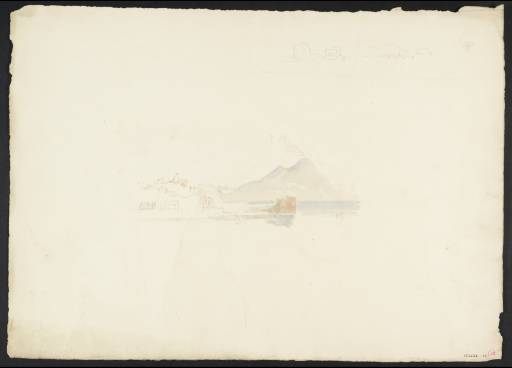This is an unfinished study for
Naples¸ the vignette that Turner produced for Rogers’s
Italy (see Tate
D27660; Turner Bequest CCLXXX 143). In the final version of the illustration, Turner retained the background view of a smoking Mount Vesuvius but changed the foreground composition considerably, eliminating the town overlooking the bay and replacing it with a wide view of the gleaming, boat-filled water. The two thumbnail pencil sketches located in the top right of the sheet probably represent Turner’s experimentation with the appearance of the town on the left side on the composition. In designing the view, Turner may well have referred to the many drawings of the Bay of Naples that he made during his visit there in 1819. However, none of his on-site studies appear to have served as direct models for this view of the bay (see the
Gandolfo to Naples sketchbook, Turner Bequest CLXXXIV
Pompeii, Amalfi sketchbook, Turner Bequest CLXXXV and
Naples, Paestum, and Rome sketchbook, Turner Bequest CLXXXVI).
The prominence of Mount Vesuvius in this study may have been intended to highlight Rogers’s description of the volcano erupting:
But here the mighty Monarch underneath,
He in his palace of fire, diffuses round
A dazzling splendour. Here, unseen, unheard,
Opening another Eden in the wild,
He works his wonders; save, when issuing forth
In thunder, he blots out the sun, the sky,
And, mingling all things earthly as in scorn,
Exalts the valley, lays the mountain low,
Pours many a torrent from his burning lake,
And in an hour of universal mirth,
What time the trump proclaims the festival,
Buries some capital city, there to sleep
The sleep of ages
(Italy, pp.191–2)
Although Vesuvius is most famous for destroying the Roman cities of Pompeii and Herculaneum in 79 AD, it was also unusually active in the eighteenth and nineteenth centuries. It erupted six times during the eighteenth century and again in 1822, less than a decade before the publication of Rogers’s Italy.

